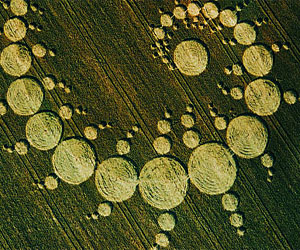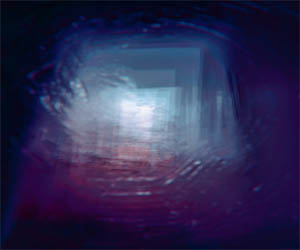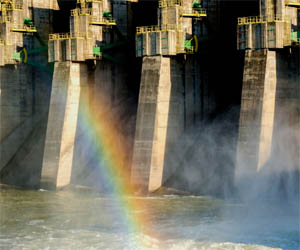


Nature's Enigmatic Canvas

Crop circles, those intricate and often mesmerizing geometric designs found in fields of crops, have captured the imagination of people around the world. These patterns, ranging from simple circles to elaborate and complex designs, have long been subjects of fascination and curiosity. In this article, we explore the captivating world of crop circle patterns and designs.
Variety And Complexity
Crop circle patterns come in an astonishing variety of shapes and sizes. While some formations are relatively straightforward, consisting of circular shapes or simple lines, others are incredibly intricate, featuring complex geometric designs, fractals, and even depictions of animals, celestial bodies, and intricate mathematical equations. This diversity is one of the factors that make crop circles so intriguing.
Geometric Precision
One of the most striking aspects of crop circle designs is the precision with which they are executed. The symmetry, mathematical ratios, and proportional accuracy found in many formations have left experts and enthusiasts alike in awe. The complexity of these patterns suggests a level of artistic and mathematical skill that challenges conventional explanations.
Symmetry And Symmetry Breaks
Symmetry is a common feature in crop circle patterns, with many formations exhibiting bilateral or radial symmetry. However, some crop circles also incorporate "symmetry breaks," where the pattern appears to intentionally deviate from perfect symmetry, introducing intriguing irregularities or asymmetrical elements.
Fractals And Self-Similarity
Fractal patterns are another fascinating component of crop circle designs. Fractals are complex shapes that exhibit self-similarity, meaning that they repeat similar patterns at different scales. These formations often evoke a sense of wonder, as the same design can be observed both in its overall shape and in its smaller components.
Incorporation Of Natural Elements
Some crop circle designs incorporate elements from the natural world, such as leaves, plants, and even flowing water. These designs can be particularly captivating, as they blend human creativity with the organic world, blurring the lines between nature and art.
Historical Evolution
The history of crop circle patterns reveals an interesting evolution. Early crop circles were relatively simple in design, often consisting of circles and basic shapes. Over time, they have become increasingly complex and intricate, featuring ever more precise geometric elements and incorporating elaborate symbolism.
Artistic And Aesthetic Appeal
Crop circle patterns are not just geometric marvels; they also possess a significant artistic and aesthetic appeal. Many formations are visually striking, and their beauty has inspired artists, photographers, and enthusiasts to capture their essence in various art forms.
Crop circle patterns and designs continue to be a source of intrigue and fascination. The precision, complexity, and aesthetic appeal of these formations have made them enduring subjects of study and discussion. Whether attributed to natural forces, human creativity, or even extraterrestrial involvement, the patterns etched into fields of crops remind us of the potential for artistic expression in unexpected places and the mysteries that continue to captivate our collective imagination.
Fact Or Fiction?
 The power of suggestion is at the heart of hypnosis, but it has its limits. During a hypnotic session, the subject is more receptive to suggestions, which can influence their thoughts, emotions, and behaviors to a certain extent. Hypnotherapy, for example, is used to address various issues such as smoking cessation, weight loss, and stress reduction by reinforcing positive suggestions in the subject's subconscious mind.
The power of suggestion is at the heart of hypnosis, but it has its limits. During a hypnotic session, the subject is more receptive to suggestions, which can influence their thoughts, emotions, and behaviors to a certain extent. Hypnotherapy, for example, is used to address various issues such as smoking cessation, weight loss, and stress reduction by reinforcing positive suggestions in the subject's subconscious mind.
However, even in a hypnotic state, the subject has the power to reject suggestions that go against their core values. In essence, the subject retains control over their actions and decisions. Ethical hypnotherapists are bound by strict guidelines to ensure they do not exploit this suggestive power to manipulate or harm their clients.
In rare cases, individuals with vulnerable or suggestible personalities may be more susceptible to external influence, even outside of hypnosis. Still, this does not equate to mind control but rather an increased responsiveness to external suggestions.
It's important to note that hypnosis cannot be used to extract confidential information, reveal hidden secrets, or manipulate individuals for malevolent purposes. The portrayal of mind control through hypnosis in fiction is often far removed from the real-world capabilities of this therapeutic technique.


The Art Of Dream Interpretation
 Symbols In Dreams: Dreams often manifest as a collage of symbols, each with its unique significance. Common dream symbols may include animals, objects, people, and landscapes. Interpretation involves associating these symbols with their emotional and psychological connotations.
Symbols In Dreams: Dreams often manifest as a collage of symbols, each with its unique significance. Common dream symbols may include animals, objects, people, and landscapes. Interpretation involves associating these symbols with their emotional and psychological connotations.
Emotions In Dreams: Emotions play a crucial role in dream interpretation. The feelings experienced within a dream can reveal the dreamer's emotional state, unresolved conflicts, or desires. Analyzing the emotional content of dreams can be a key to self-awareness.
Freudian Interpretation: Sigmund Freud, the father of psychoanalysis, proposed that dreams are a window into the unconscious mind. He believed that dream symbols often represent hidden desires and unresolved conflicts. Freudian dream interpretation is centered on the idea of wish fulfillment.
Jungian Interpretation: Carl Jung, another influential psychologist, introduced the concept of archetypes into dream interpretation. Jung believed that dreams reflect universal themes and symbols. Jungian dream analysis involves exploring the collective unconscious and personal symbols.
Embracing Sustainability And Environmental Responsibility
 2. Energy Efficiency
2. Energy Efficiency
Energy efficiency is a fundamental pillar of a clean energy future. It involves the optimization of energy use across various sectors, including residential, commercial, and industrial settings. Energy-efficient technologies, improved building designs, and sustainable practices reduce energy waste, lower energy bills, and cut greenhouse gas emissions.
3. Electrification Of Transportation
Transitioning from gasoline and diesel-powered vehicles to electric vehicles (EVs) plays a pivotal role in reducing carbon emissions. EVs produce zero tailpipe emissions, significantly lowering the carbon footprint of transportation. The expansion of EV charging infrastructure and the development of advanced battery technologies are driving this transformation.
4. Energy Storage Solutions
Energy storage technologies, such as advanced batteries and grid-scale storage, enable the integration of intermittent renewable energy sources into the power grid. These solutions ensure a reliable and consistent energy supply, regardless of weather conditions or time of day.
5. Carbon Capture And Utilization
Carbon capture and utilization (CCU) technologies capture carbon dioxide emissions from industrial processes and convert them into valuable products. CCU not only reduces emissions but also contributes to the circular economy by repurposing carbon dioxide as feedstock for fuels and chemicals.
6. Sustainable Urban Planning
Sustainable urban planning promotes eco-friendly city designs that reduce energy consumption and emissions. Compact, walkable cities with efficient public transportation systems and green infrastructure offer residents a high quality of life while minimizing their environmental impact.






Techniques For Induction
 Dream Journaling: Keeping a dream journal is an essential tool for lucid dream induction. As soon as you wake up, jot down the details of your dreams. This practice helps you become more attuned to your dream world, notice recurring patterns, and identify dream signs that can lead to lucidity.
Dream Journaling: Keeping a dream journal is an essential tool for lucid dream induction. As soon as you wake up, jot down the details of your dreams. This practice helps you become more attuned to your dream world, notice recurring patterns, and identify dream signs that can lead to lucidity.
Mnemonic Induction Of Lucid Dreams (MILD): MILD is a technique developed by Dr. Stephen LaBerge, a pioneering researcher in lucid dreaming. Before falling asleep, repeat a mantra or affirmation, such as "I will be aware that I am dreaming," or "I will have a lucid dream." The key is to believe in your intention and maintain focus as you drift off to sleep.
Wake-Back-To-Bed (WBTB): The WBTB technique involves waking up during the night, staying awake for a brief period, and then going back to sleep with the intention of having a lucid dream. This strategy leverages the increased likelihood of entering a dream directly into a state of awareness after being awake.
Visualization: Visualization techniques involve imagining yourself in a lucid dream scenario before sleep. By vividly imagining the sensations and experiences of a lucid dream, you can prime your subconscious mind to create these experiences during the dream state.
Transforming Trash Into Power
 Diverse Sources Of Waste
Diverse Sources Of Waste
One of the remarkable aspects of renewable energy from waste is the diversity of waste sources that can be utilized. This includes municipal solid waste, agricultural residues, industrial by-products, and even sewage sludge. By tapping into these sources, we not only reduce the amount of waste ending up in landfills but also create opportunities to produce clean energy.
Environmental Benefits
Generating renewable energy from waste offers several notable environmental benefits. It significantly reduces the emission of greenhouse gases compared to traditional waste disposal methods. Moreover, it lessens the need for landfills, which can be detrimental to the environment, often contaminating groundwater and emitting harmful gases. WTE technology ensures a more controlled and cleaner approach to waste management.
Reducing Fossil Fuel Dependence
A fundamental advantage of renewable energy from waste is its potential to reduce our reliance on fossil fuels.